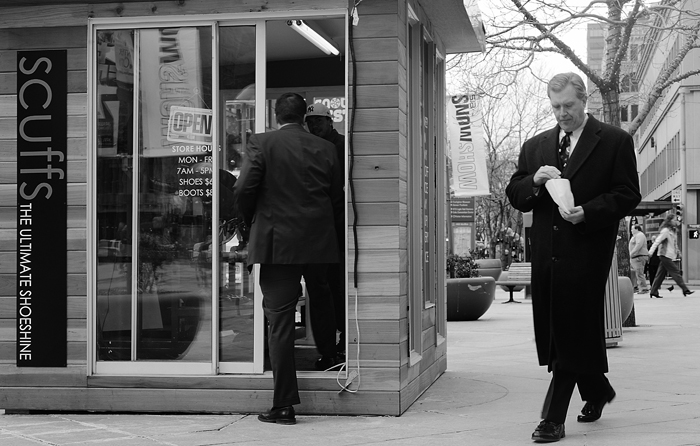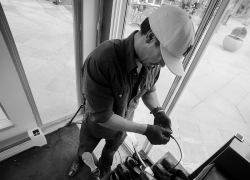Mulling Over the Mall
 By Kristin Pazulski
By Kristin Pazulski
Photography by Adrian DiUbaldo
Another group of casually dressed business people runs by you, trying to catch the bus, talking about the latest speaker and wearing lanyard tags naming the convention they are attending at the Hyatt.
You look down at your jeans and sweater, and wonder if you’re supposed to be wearing a suit to be on the 16th Street Mall, because that’s all you can see. But no, it’s just that Denver’s downtown is different. With fewer people living in Denver than working and visiting, the downtown area’s one dominating street, the 16th Street Mall, sees more traffic from the more than 100,000 office workers and 2.1 million annual visitors than it sees from Denver residents.
Not only that, but walk a block off of 16th Street and the story is much different.
Downtown Denver is dominated by a 15-block strip of stores, restaurants and vendors that attract most of the area’s pedestrian traffic. The Mall Ride is beeping, bags are rustling, conversations float from cafes and the street furniture as people take a rest from shopping or walking. But the adjoining streets are quiet. There are shops and restaurants—plenty of shops, some which have been there for years. But the bustle is missing. Cars whizz by in four lanes of one-way traffic. The white-walking-man lights go on, but only a few people saunter across the street—most on their way to a hotel, a bus stop or the Mall.
Those side streets could be the future of Denver’s downtown development, but having oriented the city around one street, what will it take to build a more balanced city-center—one with shopping, entertainment, residences and pedestrian areas throughout?
Wolf Camera is a perfect example of how the city’s original plan to focus on the 16th Street Mall has backfired. The camera shop moved from the corner of 15th and California streets to the mall in October. The shop is just a block from its former location, but sales associate Josh Olsen said the difference is huge.
“There is an incredible difference in traffic,” said Olsen. “We were … off the beaten path a little on the corner, where people who are out of town, who are visiting, couldn’t see us. Before there was no reason for them to go to 15th street. It’s not really pedestrian friendly like 16th Street is.”
Olsen’s point about pedestrian friendliness is a significant one, and it’s something developers, city planners, businesses and the Downtown Denver Partnership (DDP) have been considering for years.
The 16th Street Mall was developed in the 1970s, officially opening on October 4, 1982, as the “spine” of Denver’s downtown. There have been various improvement plans developed for the mall in its 28 years, the latest in 2007, when the city and the DDP began looking at what it will look like in 20 years and saw the possibility of growing its popularity beyond the single street.
 Scuffs shoeshine, owned by David Shalmoni, recently set up a kiosk on the mall. Brian Phetteplace says these types of smaller, kiosk-style businesses might become more prominent in the future of 16th Street.“If you look and compare the ’86 plan to the 2027 area plan, you’ll see that ’86 was so much more focused on 16th Street Mall as the spine and center of downtown,” said Brian Phetteplace, DDP’s manager of Residential and Retail Development. “The 2027 plan is more about all of the small steps in making downtown a more pedestrian-friendly place.”
Scuffs shoeshine, owned by David Shalmoni, recently set up a kiosk on the mall. Brian Phetteplace says these types of smaller, kiosk-style businesses might become more prominent in the future of 16th Street.“If you look and compare the ’86 plan to the 2027 area plan, you’ll see that ’86 was so much more focused on 16th Street Mall as the spine and center of downtown,” said Brian Phetteplace, DDP’s manager of Residential and Retail Development. “The 2027 plan is more about all of the small steps in making downtown a more pedestrian-friendly place.”
A number of projects are already in the works to make the adjoining streets more pedestrian friendly. In November, a yearlong $14 million construction project began on 14th Street to make the corridor more pedestrian friendly with wider sidewalks and aesthetic improvements. California Street has received various improvements in the past few years and the Larimer Street sidewalk-extension is just about finished.
“When you look at 17th and you look at 16th and you look at 14th, all of the pieces are starting to be there,” Phetteplace said.
But the biggest challenge to expanding the downtown area is perception. He agreed that people’s perception of downtown, even with pedestrian improvements, is of a segmented place. There is Larimer, LoDo and the mall, and even though these places are blocks from each other, they are not always viewed as cohesive.
“I think with every situation you have to look at the perception versus the reality, and sometimes you can’t change that,” he said. “If people perceive something is not [pedestrian] friendly, it can take a long time.”
Phetteplace said the pedestrian improvements will help, but that filling the retail on the mall can be a catalyst for pushing businesses, and then people, down the side streets and changing the perception.
“I think the most important thing with that is giving people a reason to [walk down the side streets], and right now we’re not at a critical mass necessarily on the side streets to make that happen,” he said. “And that’s part of this process, part of this kind of this journey, is how do we get it to that point where the mall itself is completely full and there are no other opportunities, so a retailer who wants to be as close as possible [will] have to [locate to a side street].”
There is not much vacant space on the mall, according to Phetteplace. Ninety-seven percent of 16th Street Mall’s retail is in use, he said, but there is a perception of vacancy because that three percent of empty retail space includes large locations, such as the former Virgin Records Megastore in the Pavilions and the former ESPN Zone at Lawrence Street.
And quickly filling space on the mall is a challenge.
Property owners are in the driver’s seat when it comes to leasing, and DDP can only do so much. Some property owners prefer to hold out for a specific use, like the owners of the SugarCube Building at 16th and Blake streets which held out for higher-end restaurant concepts, H|Burger and ChoLon Asian Bistro.
“We can’t control rent and we can’t control the landlord negotiations so we feel we’re doing the best we can given the market where we can affect change and keep in mind of it and seek out opportunities where we can,” Phetteplace said.
Then there is the cost. While these spaces are appealing, with a set audience of about 2.1 million visitors to downtown a year, not to mention the approximate 110,000 office workers and about 10,000 downtown residents, space on the mall is expensive.
“I suspect [businesses] are initially very interested [in locating on 16th Street] and then they find out that rents can be as high as $40, $50, $100 a square foot. Well, very few business models for even national retailers can make that work,” Phetteplace said.
DDP is hoping that increasing its vendor program, a less expensive option for opening a business on the mall, will help develop a slew of businesses. The hope is they will benefit from the low overhead and high traffic, and eventually open in future empty spots along or right off 16th Street.
Currently there are 24 vendors on the mall, and the rent for these businesses range from $260 to $380, depending on the season and electricity use. Most have removable carts, selling food or retail accessories and are removed each day. Others lease former DDP information kiosks.
 David Shalmoni works in his shoeshine kiosk on 16th StreetDavid Shalmoni has been shining shoes on 16th Street for almost two years. Last month, he built a DDP-approved shelter around his three-seat shine station to weather the weather better. He said being able to work on the mall without having to pay an in-line store rent is a huge advantage. It basically allows him to do what he loves—chat with people from all walks of life as he shines.
David Shalmoni works in his shoeshine kiosk on 16th StreetDavid Shalmoni has been shining shoes on 16th Street for almost two years. Last month, he built a DDP-approved shelter around his three-seat shine station to weather the weather better. He said being able to work on the mall without having to pay an in-line store rent is a huge advantage. It basically allows him to do what he loves—chat with people from all walks of life as he shines.
“I honestly think I have, for my business, the best spot on the mall. Overhead is low and if you’re an entrepreneur like myself that doesn’t have a lot of start up capital, building out of brick and mortar, that type of business, is unfeasible,” Shalmoni said. “I can’t afford that. So I think it’s great that the Downtown Denver Partnership allows this because it gives small guys with less start up money to take a stab at owning a business and building upon that.”
Expanding the vending opportunities by creating more permanent kiosks and possibly clustering them to create small retail destinations could help diversify the retail mix on the mall and support smaller businesses. At least that’s DDP’s hope.
Already the DDP has tried allowing non-DDP owned permanent kiosks on 16th Street, but both businesses left shortly after opening due to their own business issues, Phetteplace said. Both the EVOBEAN Coffee cart between Glenarm Place and Welton Street and the NewsCube on California Street were examples of this effort.
Investors have recognized the popularity of the mall, and more importantly are recognizing the potential growth.
Last year Gart Properties and ING invested $25 million in renovating the Denver Pavilions and in 2008, Chartres Lodging invested $70 million into renovating the former Adam’s Mark Hotel into the Downtown Denver Sheraton. In 2008, Writer’s Square was purchased for $58.4 million by GDA Real Estate Services Inc. and ACF Property Management, which are working to renovate that space.
While the mall is currently dominated by the working- and visiting-crowd, there should be a shift coming. Just this year, two new residential properties opened downtown—the new hi-rise SPIRE which is expected to have about 500 new residents once it’s full (currently the building is 50 percent full) and the new Four Seasons Hotel at 14th and Arapahoe Streets includes 100 condos.
So maybe, instead of business and track suits dominating the patios, a drop-in to the grocer (if one opens downtown) or even the local watering hole will bring greetings from your neighbors rather than the distant laugh of visitors from another convention. Couples with children will be running to catch the Mall Ride and teenagers will come bopping out of Forever 21 after a quick stop on the way home from school.
